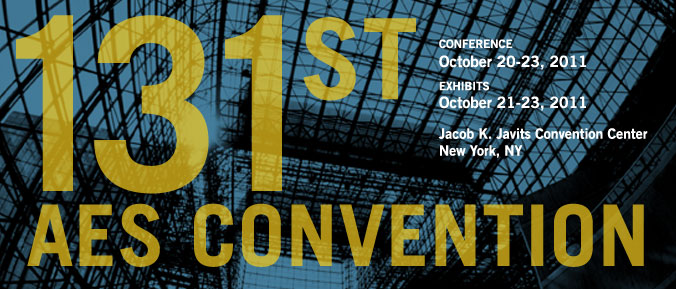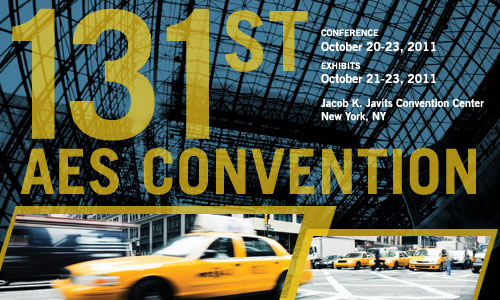
AES New York 2011
Poster Session P17
P17 - Audio Equipment and Measurement
Friday, October 21, 4:30 pm — 6:00 pm (Room: 1E Foyer)
P17-1 Swept Sine Grains Applied to Acoustical Measurements Using Perceptual Masking Effects or Musical Compositions—Joel Preto Paulo, ISEL- Instituto Superior de Engenharia de Lisboa - Lisbon, Portugal, CAPS—Instituto Superior Tecnico, TU Lisbon, Lisbon, Portugal; J. L. Bento Coelho, IST- CAPS—Instituto Superior Tecnico, TU Lisbon - Lisbon, Portugal
The swept sine technique has proven to lead to accurate estimations of the room impulse response, even in situations of low SNR, non-linearity, and time-variance of the system under test. Regarding the distributive property of the convolution, the swept sine signal can be split into several segments, namely grains, and sent separately to the room. At the reception, the full frame is assembled from the grains by applying the overlap-add based procedure. Choosing appropriate windows, values to the truncation and the overlap of the captured grains, the degree of degradation on the final results, measured by the amount of produced noise, can be controlled. Therefore, each grain can be matched according to the tempered musical scale, which can be applied on musical compositions, or used in perceptual models, taking into account the human auditory masking effects, to compose a test signal frame for acoustical measurements. The possibility of polyphony musical compositions for use on acoustical measurements is assessed and discussed.
Convention Paper 8534 (Purchase now)
P17-2 Multichannel Impulse Response Measurement in Matlab—Braxton Boren, Agnieszka Roginska, New York University - New York, NY, USA
This paper describes ScanIR, an application for flexible multichannel impulse response measurement in Matlab intended for public distribution. The application interfaces with the PortAudio API using Psychtoolbox-3, a toolkit in Matlab allowing high-precision control of a multichannel audio interface. ScanIR contains single-channel, binaural, and multichannel input modes, and it also allows the use of multiple output test signals. It is hoped that this application will prove useful to researchers using Matlab for physical or psychological acoustic measurements.
Convention Paper 8535 (Purchase now)
P17-3 Why Do Tube Amplifiers Have Fat Sound while Solid State Amplifiers Don't?—Shengchao Li, Wintersweet Electronics, LLC - Potomac, MD, USA
I propose an explanation to why tube amplifiers sound better than solid state amplifiers in certain circumstances. The explanation is, the interaction of (1) the nonlinearity of the output tube, (2) output impedance of the amplifier, and (3) the nonlinearity of the output transformer inductance caused by core material B-H curve, results in a frequency selective nonlinear feedback system that softly limits the speaker cone excursion for low frequency music signals with excessive amplitude, while has little effect on high frequency music signals or low frequency music signals with low to moderate amplitude. Better yet, when low frequency music signals with excessive amplitude is superposed with high frequency music signals, this system selectively limits low frequency music signals and has little effect on the superposed high frequency music signals. Comparing to that of a typical solid state amplifier, this mechanism trades some amplifier nonlinearity for less speaker nonlinearity, resulting in less overall nonlinearity of the music sound waves people's ears perceive.
Convention Paper 8536 (Purchase now)
Information Last Updated: 20111005, mei

